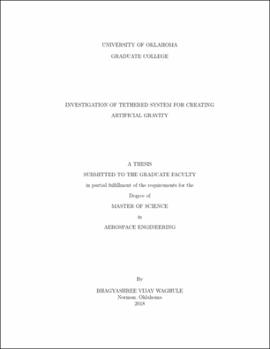| dc.description.abstract | Interplanetary journeys are long; taking anywhere between 6 months to a few years. Studies performed with astronauts in the various space missions have provided insights on adverse effects of microgravity on the human body. Artificial gravity provides a solution to keep humans healthy in such long duration interplanetary journey. Various designs have been studied to create artificial gravity, out of which, a tethered spinning system is the most promising due to its compact structure and ability to vary the radius of rotation. Though theoretically the most promising, little investigation has been done concerning the tethered system for artificial gravity. Speculative studies and some experiments on manned and unmanned missions have been done to analyze the rotating tethered system in Earth's orbit. These studies were performed in the Lower Earth Orbit. Such studies provide an excellent opportunity to speculate about the conditions during a trajectory to Mars.
The primary purpose of this thesis is to investigate the amount of propellant required to spin the tethered system and tether materials, and also to find the deployment velocity on a trajectory to Mars. This system will increase the radius of rotation to reach a distance of 1 km from the center of rotation. To create artificial gravity, the capsules will be spun using thrusters till they reach a distance of 1 km each. This increase in the radius of rotation creates the need to investigate the amount of propellant to spin-up and spin-down (varying the radius of rotation), as well as the rate of deployment of the tether. Ion thrusters are selected to propel the capsules, because of its low thrust and better controllability.
The propellant requirement is estimated using the rocket equation. Traditionally, the equation is used to determine the propellant required for long distances. In this thesis, we will use the same concept for a smaller change in velocity for the spin-up procedure. To find the amount of propellant required we have considered three scenarios in which the propellant could be used by incrementing energy, radius, and velocity in steps. The steps are crucial in determining the change in tangential velocities, and by extension mass of propellant required. A balance of deployment velocity and thruster engagement will ensure constant acceleration on the floor.
The results from the simulation indicate that approximately 165 kg of fuel is required for the spin-up procedure when deployed at a gradually increasing rate, never exceeding 3 m/s. The deployment rate will help in ensuring humans in the capsules feel comfortable. This outcome will provide insight into the further investigation in the tethered system for controlled artificial gravity for human factors, tether material, and tether control. With growing interest in manned missions, an economical option needs to be investigated thoroughly. The outcome of this will provide insights on areas of further investigation to make the tethered system a reality. | en_US |
